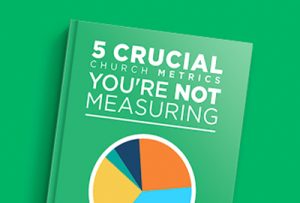The 5 Metrics Pastors Should Be Tracking but Aren’t
Updated October 11, 2023 |
Numbers don’t matter one bit. Let’s get that out of the way. Numbers won’t win your community to Jesus. Numbers can’t help an addict find new life. Numbers won’t comfort parents after the loss of their child. Numbers won’t even help your church softball team win the league title. Numbers can’t help you with squat.
Except when they do.
Like Rick Warren said, ”Numbers matter because they represent people.” But numbers by themselves won’t do you any good—that’s why metrics can be really important.
You may already be measuring a couple church metrics. Most ministries use some form of metrics to evaluate their effectiveness—even if they are “old-school” metrics like attendance and giving. But there are a 5 key metrics few churches are measuring—but every church should.
1. Attendees Becoming Members
For years, church attendance has been the holy grail of church metrics. But let’s face it. Anyone can gather a crowd, but the church has been called to make disciples. Instead of trying to discern how many people show up each week, what if you asked how many of those who show up are actually being discipled?
For most churches, the pathway into disciple-making starts with church membership. Why? First, church membership requires commitment—which is a starting point for discipleship anyway. Also, members are much more trackable than attendees. Most discipleship pathways assume church membership as a starting point. Pastor and author, Ed Stetzer, says it this way: “Membership doesn’t save us. But it enables us to grow and become spiritually mature in Christ.” So instead of tracking church attendance, consider how many attendees are committing to the church through membership?
What does this metric tell you? You’ll learn how effective your church has been at guiding attendees onto a membership and discipleship path.
To learn more about this or the other top 4 metrics churches should be tracking, download the free resource, 5 Crucial Church Metrics You’re Not Measuring, today. You’ll hear from other forward-thinking church leaders about why growth can be best assessed using these metrics and how to best track them.
2. Neighborhood Flourishing
Most ministry statistics relate to what’s happening within the church community. That’s understandable. Those are the numbers that are easiest to track. But Mark Clifton, the senior director of the North American Mission Board’s rePlanting team, suggests that one of the most important proofs for the health and vitality of any church is whether the community would miss the congregation if it were gone.
Making disciples who make disciples must lead to a transformed neighborhood around the church. While this kind of metric frees us from an over-reliance on numbers, it raises the bar significantly as it relates to discipleship. Instead of just tracking attendance, let’s think instead of increased neighborhood health.
So what are some metrics church leaders can consider when measuring for neighborhood improvement?
- Crime rate: When your church engages and begins to disciple your neighborhood, you should see fewer people committing crimes.
- Graduation rate: Your local high school should graduate more of the neighborhood’s youth.
- Divorce rate: You should expect to see more families staying together.
Remember, these metrics will look different in every church—and in every community. Only your church can properly define the change you hope your congregation will be for your community and how you’ll become indispensable in the process. Neighborhood flourishing metrics are big-picture numbers you discover together with your leadership team—or ideally your whole church. Dream together. Ask yourselves how you’d hope the community would be different in five, 10, and 15 years because of your love and care for those nearby.
What do these metrics tell you? Neighborhood flourishing statistics tell you how well you are positively impacting the community surrounding your church.
3. Members Who Give
Few church metrics come with so much baggage as those centered around giving. In 21st-century North America, generosity gives us a bird’s-eye view into the human heart like no other church metric. Johnny Hunt, longtime pastor of First Baptist Church of Woodstock, Georgia, puts it this way: “You’re never more like Jesus than when you give.” If Jesus is the spiritual-maturity barometer of a discipled Christian, then generosity has to be a critical part of the equation.
That’s why you want a giving metric that measures the breadth of your giving across your church membership. If your congregation as a whole isn’t giving—or giving is relegated to a relative few—you can assume you have people who need additional discipleship in the area of generosity.
Depending on how your church tracks giving, this metric shouldn’t be tough to determine. Whoever manages church finances can simply isolate all your members’ giving records and count up the number of people who have given in the past month. Divide that number by your church’s total number of givers.
Technology can be an extremely beneficial element to your ministry, particularly when it comes to generosity and tracking. Did you know that the percentage of people using their smartphones to shop on Amazon cracked the 70 percent mark in December of 2015? Facebook sees similar mobile use. In fact, in April of 2016, Facebook reported that 79 percent of its advertising revenue came through mobile ads. There are even articles being published on the importance of mobile giving for churches that cite some very important metrics, such as, 3 Reasons Why Your Church Needs to Consider Mobile Giving for Offering & Tithes.
The world today regularly interacts via smartphone, and if your church is not taking advantage of this shift, you are not only missing out on connecting more with your community, but you are also missing out on the valuable metrics that come with it. Unbelievable metrics can be accessed when using a mobile solution like Pushpay’s custom mobile apps powered by Pushpay’s mobile giving platform. If you’re using this technology, giving metrics, like the percentage of members who give, are a snap to calculate. You’ll have this number and more at your fingertips. You’ll even be able to zero in on specific segments of your members’ giving patterns.
What does this metric tell you? You’ll learn how well you’ve discipled your congregation in the area of generosity
4. Members Engaged
Churches that can’t engage members in Sunday School classes, small groups, and ministries will find they can’t keep members long term. Thom Rainer, president of LifeWay Christian Resources, writes about church members who become disconnected from groups within their congregation: “It is almost inevitable that, without the accountability and fellowship a small group brings, that person is headed to be a complete church dropout.”
People come to your church for a variety of reasons—the preaching, the music, and sometimes to be a part of your ministry efforts. But people stay at your church because they’ve built relationships. In other words, people stay because someone will miss them if they drop out of church life. Often, those relationships come from small groups or Sunday School classes where members are intentional about living life together. But that’s not the only place people build relationships within a local church. Groups also form around ministries and outreach efforts as well. You can’t (or shouldn’t) dismiss the relationships that form within your church choir, children’s ministry, greeter ministry, or after-school ministry.
What does this metric tell you? You’ll learn how connected your members are to your church body.
5. Members Participating in an Outreach Experience
Rick Warren has said, “You measure a church’s strength not by its seating capacity but by its sending capacity.”
The Great Commission calls churches to be disciple-makers above and beyond anything else we try to do as a congregation. Disciples reproduce themselves. At its heart, that’s the mission that Jesus has given His Church through the Great Commission. Yet, measuring missions has never been easy. Measuring how many people come to faith in Christ or join the church captures a metric for which only the Holy Spirit can truly take credit. Instead, we can measure how effective we are at preparing our congregation to pursue the Great Commission. That’s where defining the percentage of your members who participate annually in an outreach experience can help.
If a large percentage of your community isn’t participating at all, it’s time to explore the Nurture framework. This strategy walks churches through a simple, four-step process that encourages deeper engagement and participation with time. Click here to learn how your church can better reach, impact, and nurture your congregants.
What does this metric tell you? You’ll discover how effective your church has been at mobilizing the entire congregation for outreach.
Finding and Ministering to Missing Sheep
Good ministry can’t be quantified, they say. Jesus didn’t care about numbers. We shouldn’t either.
But Jesus did care about numbers. Think about His parable of the lost sheep in Luke 15. You can’t read it without thinking about numbers. In fact, when Jesus wanted to tell a story to demonstrate His passion to reach those who are lost, He told a story about metrics. When Jesus talks about the man who would leave 99 sheep to go after the one that is missing, He assumes you’d count your sheep. A shepherd who doesn’t count his sheep will never know if one is missing!
So, of course, numbers themselves mean nothing for churches. But for any church that cares for that one missing sheep, metrics (using numbers to measure what you’re doing) remain incredibly important.
For a deeper dive into church metrics, calculations, and ways to improve critical stats, download the free ebook, 5 Crucial Metrics You’re Not Measuring.
Featured Content
You May Also Like


